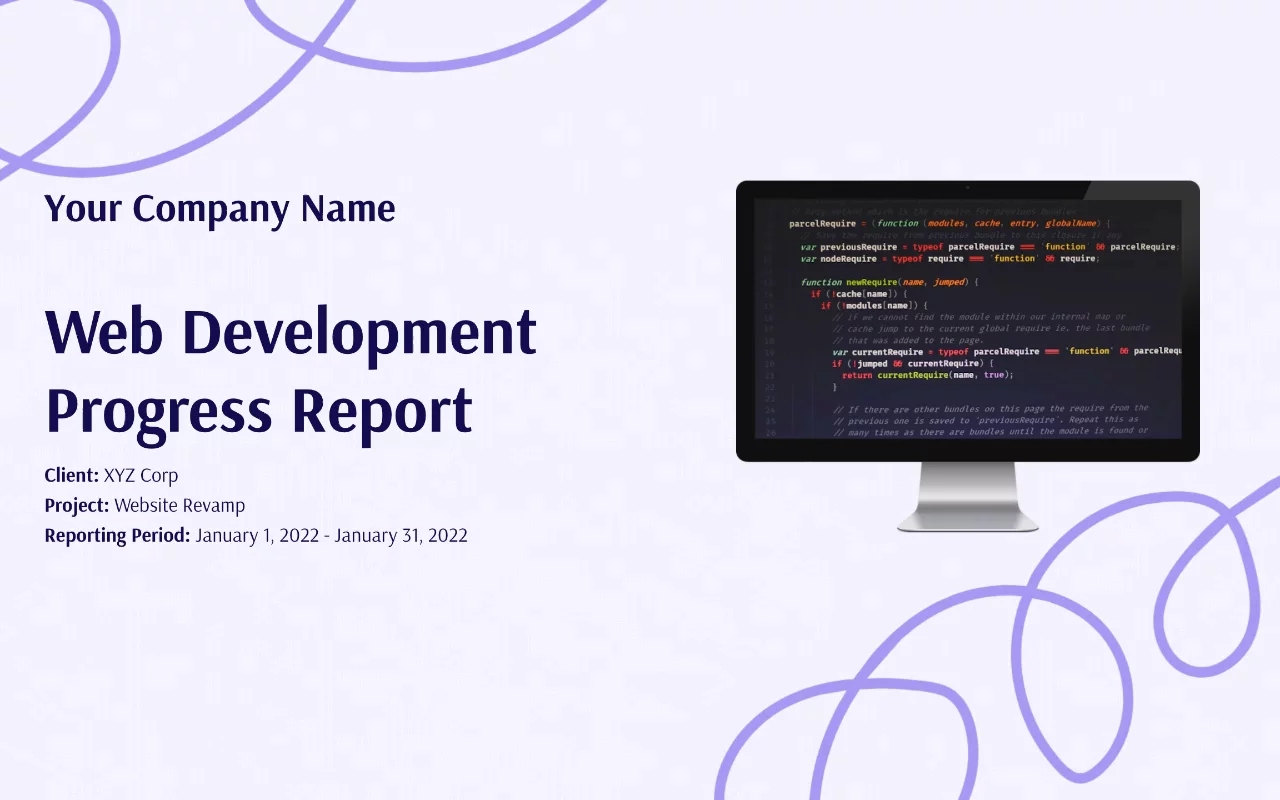Web Development Agency Progress Report Template
Keep clients informed with the comprehensive Web Development Agency Progress Report Template – present project updates, milestones, and future steps.

About this template
Keep clients informed with our Web Development Agency Progress Report Template. Ideal for presenting project updates, milestones, and future steps, this customizable template ensures effective communication and client satisfaction.
Foster transparency and trust in your web development projects with a professional progress report that highlights your achievements and plans. Our Web Development Agency Progress Report Template is tailored to showcase the value and impact of your work, positioning your agency as a reliable partner.
What's included?
- Summary
- Scope of work
- Progress & specifics
About the author

James Lambert|Software Engineer
James Lambert is a full stack engineer at Qwilr. James has a great deal of experience working with cross-functional teams that design, engineer and ship digital software.
A development progress report serves as a comprehensive record, charting the progress of a project since the last report. It conveys crucial information about the project's status, any encountered issues, and an estimated completion timeline to the client.
Using a proposal software like Qwilr, you can create interactive and visually appealing development progress reports that effectively communicate the project's status, highlight any encountered issues, and provide an estimated completion timeline. This ensures clients are well-informed and confident in the project's progression.
- Detailed Work Description: This section of the report encapsulates all tasks accomplished since the previous report. It should detail new features added, bugs rectified, and alterations made to the project's design or functionality.
- Challenges Encountered: A thorough development progress report also sheds light on any challenges faced by the development team. These can range from coding issues and unexpected delays to other difficulties encountered during the project.
- Estimated Completion Timeline: Based on the progress made and potential future roadblocks, an estimated timeline for project completion is a vital component of the report. This realistic timeline aids in managing client expectations and ensures consensus regarding the project's progression.
In essence, a development progress report is a tool that provides transparency about the project's status, documents the challenges faced, and outlines expectations for its completion. It's a critical communication medium between the client and the development team.
The use of a progress report is a cornerstone of project management, typically prepared at regular intervals throughout the lifecycle of a project. The frequency of these reports—be it weekly or monthly—is influenced by the project's duration and complexity.
- Client Communication: One of the primary reasons to utilize progress reports is to maintain open communication with the client about the project's status. Given the client's investment in terms of time and resources, they are keen to see effective utilization. Regular updates allow clients to track the project's progress and validate their investment.
- Identifying Roadblocks: Projects often encounter unexpected setbacks. If not promptly identified and addressed, these can lead to project delays and inflated costs.
- Value Assurance: Clients seek confirmation that their investment is yielding value. Progress reports provide this assurance by offering a tangible record of advancements made and value delivered.
Personalized and Professional: First and foremost, the template is highly customizable, allowing you to mold the report to align with your agency's brand and the specific requirements of each client. This degree of personalization ensures that your clients receive professional and tailor-made reports consistently.
Visual Appeal and Readability: The template is designed to strike a balance between aesthetic appeal and readability. With clear headings, subheadings, and bullet points, it facilitates quick scanning and comprehension of the information by clients. The incorporation of graphs and charts aids in data visualization, making the information even more digestible.
Easily Shareable and Professional Presentation: Qwilr's progress report template is easily shareable, serving as a perfect communication medium with clients. Whether shared via email or as a link, clients can access the report from any device. The professional layout of the report fosters trust and credibility with clients, showcasing your agency's commitment to organized, result-oriented work.
Progress Tracking: Another benefit of the progress report template is its capability to track progress over a period of time. This enables your agency to identify trends and improvement areas, which can be leveraged to optimize future projects and uphold a commitment to continual improvement.
Here's a quick video overview of how to get started with this template:
Using Qwilr's progress report template is straightforward and easy to do. Simply hit the "Use template", create a Qwilr account, customize the template with your agency's branding and client information, and fill in the relevant details about the project's progress and status.
Once completed, the report can be sent to the client via email or shared using Qwilr's online platform.
A tool packed with features
Brand control
Establish your brand settings once and automatically apply to every piece of collateral.
Payments
Collect payments instantly from customers with Stripe or direct to your own payment system.
Security & GDPR
Add security features like password protection and link expiry to protect sensitive content.
Embedded content
Add Calendly links, videos, surveys, Looms, GIFs and more to every page.
E-signature
Get deals signed on the spot with built-in e-signing ability.
Asset library
Create a library of reusable content for sales reps.
ROI calculator
Showcase your value with an interactive ROI calculator embedded in your Qwilr pages.
Team management
Set up permissions so your team accesses only what they need.
Interactive pricing
Empower buyers with interactive pricing plans and quotes.
Templates for every use case
Explore templates for sales, marketing, customer success, sales enablement and more.
Explore reporting templatesFrequently asked questions
The key to writing an effective development progress report is to be clear and concise. The report should include a summary of the work that has been done, any issues that have arisen, and an estimated timeline for completion. Additionally, the report should be visually appealing and easy to understand so that the client can quickly grasp the information presented.
A progress report should include the following information:
- A summary of the work that has been done since the last report
- Any issues that have arisen
- An estimated timeline for completion
- Any budgetary or timeline concerns
Website development progress can be measured in a variety of ways, including:
- The amount of work that has been completed
- The quality of the work that has been completed
- The adherence to the timeline and budget
- The satisfaction of the client
The key website performance metrics include:
- Load time
- Conversion rate
- Pageviews
- Bounce rate
- Mobile responsiveness
By including these key factors in your progress report, you can demonstrate the value of your work to the client and justify the costs of the project. And with Qwilr's progress report template, doing so has never been easier! Use this helpful tool to keep your clients informed and happy.






